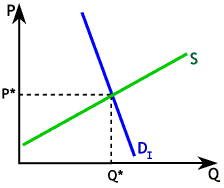

Both quotas and tariffs are forms of trade barriers. A tariff is similar to an excise or sales tax placed on imported goods. It is widely believed that the U.S. imposition of this tariff is meant as a signal to Europe that the U.S. will react strongly to the erection of trade barriers. In this article we'll examine why the tariff was placed specifically on luxury goods and what the effect of the tariff might be on consumers and producers of these goods.
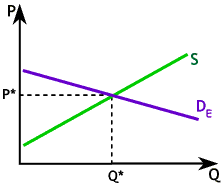
The demand for luxury goods is very elastic because they are expensive and there are many close substitutes, such as less expensive versions of the same goods. The graph to the right shows the U.S. market for European luxury goods before and after the imposition of a tariff. The demand curve is shown relatively flat to illustrate very elastic demand. P* is the equilibrium price charged for the goods prior to the imposition of the tariff. The tariff shifts the supply curve back by a vertical amount equal to the tariff. In this case a 100% tariff means the supply curve is now vertically twice a high as before. It might seem that the retail price of these goods would double with the imposition of a 100% tariff but as we see on the graph this is far from the case. Because demand is very elastic the retail price only increases to PT. Notice too that the revenue collected from a tariff placed on a good with an elastic demand is quite small. The primary effect of such a tariff is to almost wipe out the market for these goods. Note that quantity sold fell from Q* to QT, a fraction of the original amount sold. A tariff on a good with a very elastic demand primarily harms the producers of the good when export sales fall to a fraction of what they were before.

Let's compare the effects of a tariff on a market such as this with one in which demand is relatively inelastic. The graph to the left shows the effects of a tariff imposed on imported goods with relatively inelastic demand. In this case we see that, because demand is inelastic, almost all the tariff is passed along to consumers as the retail price increases to almost double what it was before. Note too that sales don't fall very much and so, the revenue collected from this tariff is large. Most excise taxes imposed in the U.S. are similar to this, with the taxes being imposed on goods with very inelastic demand and retail prices increasing by almost the full amount of the tax. A 100 percent tariff on imported goods for which demand is very inelastic would primarily harm U.S. consumers when prices almost double for the import.
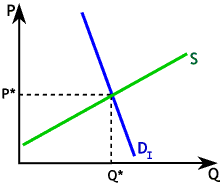
The graph to the right allows us to compare the effects of tariffs in these two markets on the same graph. DI represents the demand curve for a good with very inelastic demand while DE represents demand for goods with very elastic demand, such as those subject to this new tariff. It is easy to see that the effect of such a tariff is very different depending on the elasticity of the relevant demand curve. If demand is elastic, retail prices increase by much less, quantity sold falls by a much greater amount and the revenue collected is far smaller than in the case of a tariff placed on a good with inelastic demand.
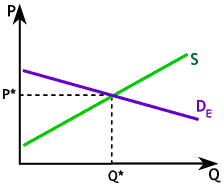
As we know, the statutory imposition of a tax or tariff and the incidence, or who really pays, are often very different depending on demand and supply elasticity. To the left we show the imposition of a tariff on a market with elastic demand again. The imposition of the tariff causes retail prices to increase from P* to PTC. Even though this increase is only a small fraction of the full tariff it causes the quantity demanded to fall dramatically. The producers fare far worse in this case. Their actual revenue per unit sold in the U.S. market falls from P* to PTP. Most of the per unit cost of the tariff is borne by producers in the form of far lower wholesale prices. On the graph we show retail prices increasing by only about 15% of the tariff while wholesale prices fall by about 85% of the tariff. The total revenue collected from this tariff is equal to the difference between the amount paid by the consumer (PTC) and the amount received by the producer (PTP) (this difference is the same as the tariff) times the quantity sold after the tariff (QT). Most of the revenue collected is paid by producers (the yellow shaded area) while a much smaller fraction is paid by consumers (the pink shaded area).
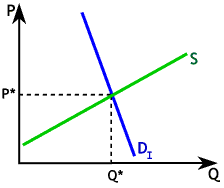
To the right we can see how this distribution of the tax burden and revenue would differ if the tariff had been placed on a good with a relatively inelastic demand. Not only could more revenue have been earned, but in the case of a good with an inelastic demand, the consumer bears most of the burden.
Suppose we didn't know this tariff was meant as a retaliatory gesture meant to send a signal to Europe that the U.S. will react to what it perceives as unfair quotas and other trade restrictions? Basic demand and supply analysis would reveal the purpose. Such a high tariff on luxury goods can only have one direct purpose, to virtually stop all imports of the goods subject to the tariff. It collects very little revenue and consumer prices in the U.S. only increase by a modest fraction of the total tariff, but sales fall dramatically and producer's revenues are reduced by almost the full amount of the tariff. In yet another way, this is by no means a typical tariff. The average tariff on imports into the U.S. is currently around 5 percent, and this tariff on European luxury goods is 100 percent, around 20 times the average! This tariff was imposed to create a tremendous drop in sales of these European luxury goods in hopes of convincing the European nations to change their quotas on bananas shipped from Latin American by U.S. owned companies.
Copyright © 1995-2003 OnLineTexts.com, Inc. - All Rights Reserved